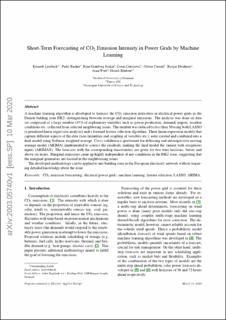| dc.contributor.author | Leerbeck, Kenneth | |
| dc.contributor.author | Bacher, Peder | |
| dc.contributor.author | Junker, Rune Grønborg | |
| dc.contributor.author | Goranović, Goran | |
| dc.contributor.author | Corradi, Olivier | |
| dc.contributor.author | Ebrahimy, Razgar | |
| dc.contributor.author | Tveit, Anna | |
| dc.contributor.author | Madsen, Henrik Tams | |
| dc.date.accessioned | 2021-03-18T07:32:00Z | |
| dc.date.available | 2021-03-18T07:32:00Z | |
| dc.date.created | 2020-12-07T17:17:14Z | |
| dc.date.issued | 2020 | |
| dc.identifier.citation | Applied Energy. 2020, 277 1-13. | en_US |
| dc.identifier.issn | 0306-2619 | |
| dc.identifier.uri | https://hdl.handle.net/11250/2734034 | |
| dc.description.abstract | With the aim of enabling effective flexible electricity demand, a machine learning algorithm is developed to forecast the CO2 emission intensities in European electrical power grids distinguishing between average and marginal emissions. The analysis focuses on Danish bidding zone DK2 and was done on a data set comprised of a large number (473) of explanatory variables such as power production, demand, import, weather conditions etc., collected from selected neighboring zones. The number of variables was reduced to less than 30 using both LASSO (a penalized linear regression analysis) and a forward feature selection algorithm. Three linear regression models that capture different aspects of the data (non-linearities and coupling of variables etc.), were created and combined into a final model using Softmax weighted average. Cross-validation is performed for debiasing and an autoregressive moving average model (ARIMA) implemented to correct the residuals, making the final model an ARIMA with exogenous inputs (ARIMAX). Forecast errors vary between 0.095 and 0.183 (NRMSE) for the average emissions and 0.029–0.160 for the marginals depending on the forecast horizon (1–24 h). The forecasts with the corresponding uncertainties are analyzed and performance on very short (below six hours) and longer horizons are discussed –. One interesting result is that the marginal emissions were shown to be highly independent of any variables in the DK2 zone, suggesting that the marginal generators are located in the neighboring zones. The developed methodology can be applied to any bidding zone in the European electricity network without requiring detailed knowledge about the zone and with very few manual interactions. | en_US |
| dc.language.iso | eng | en_US |
| dc.publisher | Elsevier | en_US |
| dc.rights | Attribution-NonCommercial-NoDerivatives 4.0 Internasjonal | * |
| dc.rights.uri | http://creativecommons.org/licenses/by-nc-nd/4.0/deed.no | * |
| dc.title | Short-term forecasting of CO2 emission intensity in power grids by machine learning | en_US |
| dc.type | Peer reviewed | en_US |
| dc.type | Journal article | en_US |
| dc.description.version | acceptedVersion | en_US |
| dc.source.pagenumber | 1-13 | en_US |
| dc.source.volume | 277 | en_US |
| dc.source.journal | Applied Energy | en_US |
| dc.identifier.doi | 10.1016/j.apenergy.2020.115527 | |
| dc.identifier.cristin | 1857147 | |
| dc.description.localcode | "© 2020. This is the authors’ accepted and refereed manuscript to the article. Locked until 31.7.2022 due to copyright restrictions. This manuscript version is made available under the CC-BY-NC-ND 4.0 license http://creativecommons.org/licenses/by-nc-nd/4.0/ " | en_US |
| cristin.ispublished | true | |
| cristin.fulltext | postprint | |
| cristin.qualitycode | 1 | |

